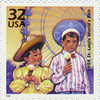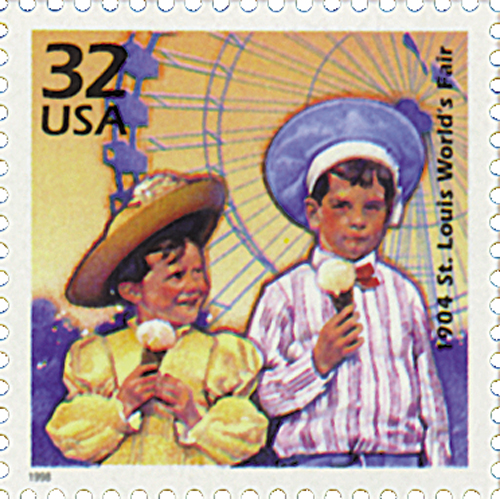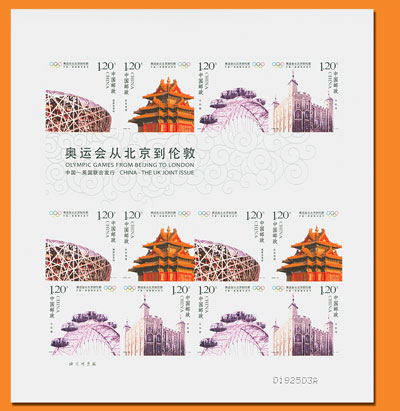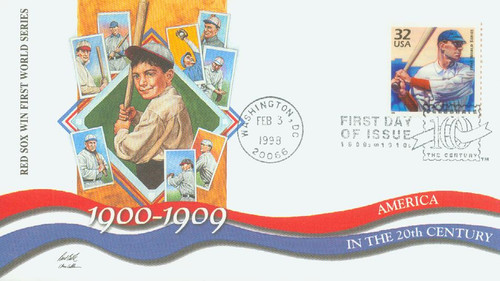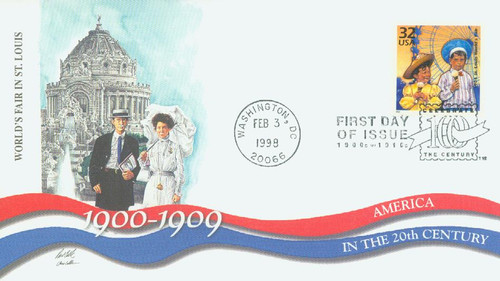
# 3182e - 1998 32c Celebrate the Century - 1900s: St. Louis World Fair
1998 32¢ St. Louis World’s Fair
Celebrate the Century – 1900s
City: Washington, DC
Quantity: 12,533,333
Printed By: Ashton-Potter (USA) Ltd
Printing Method: Lithographed
Perforations: 11 ½
Color: Multicolored
Premiere Of The First Ferris Wheel
The planners behind the exposition saw it as their chance to put America’s engineering talent on display for the world to see. Construction Chief Daniel Burnham wanted his architects and engineers to come up with something even better than the Eiffel Tower, which had wowed visitors to the 1889 World’s Fair.
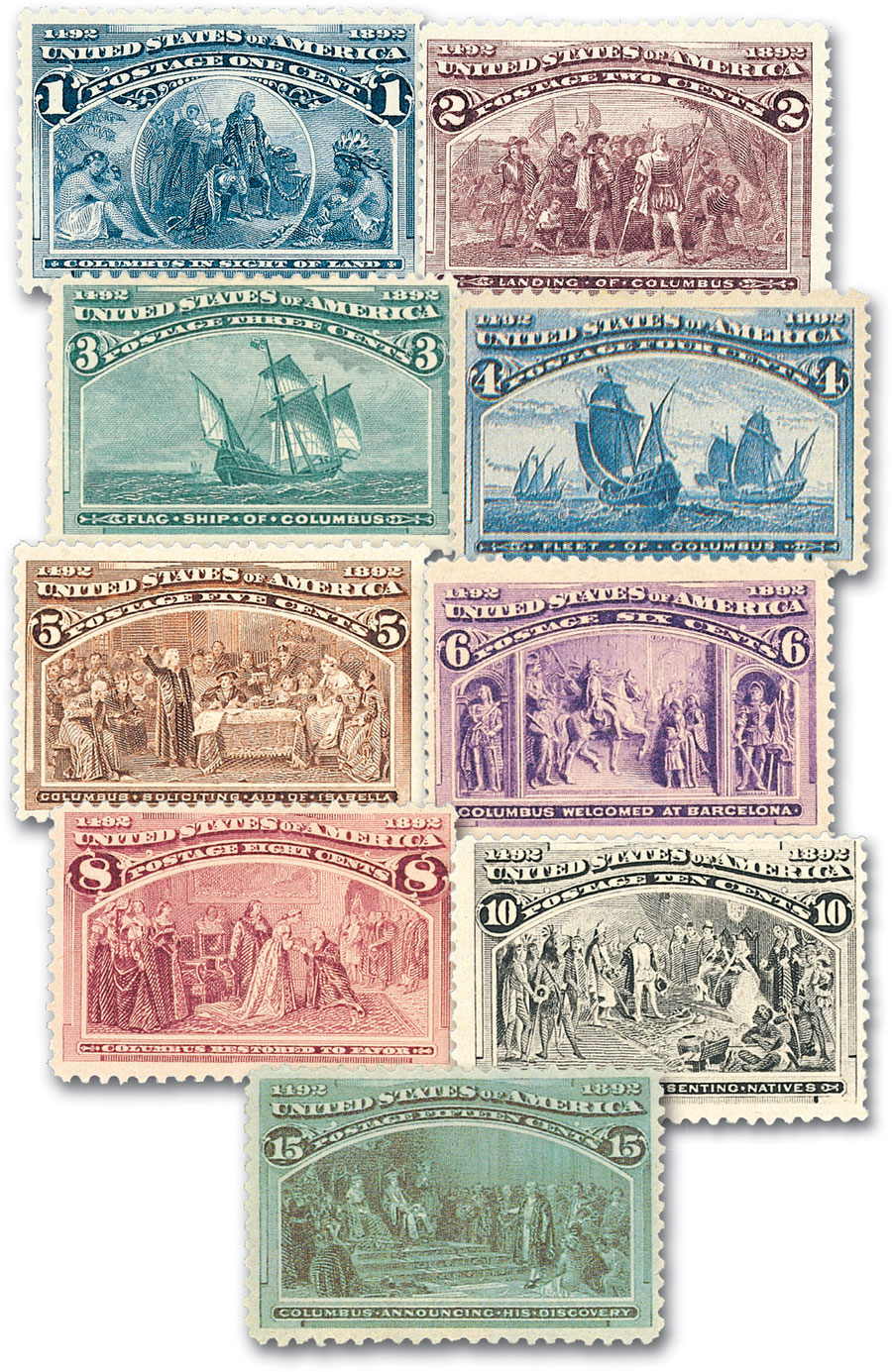
Among those who answered Burnham’s call was 32-year-old George Ferris. Ferris shared his plan for a giant observation wheel. However, the sheer size of it seemed impossible and he was rejected and his idea considered crazy. In spite of their reactions, Ferris believed in his idea and finished his plans and found the funding he needed. He negotiated with the expo’s planners and was given a plot to build the wheel on the Midway.
By the time the fair opened on May 1, 1893, the wheel was still under construction. Visitors to the fair guessed at what it might be. What they saw was a giant wheel reaching 264 feet tall. Its steel structure weighed hundreds of thousands of pounds. And its 90,000-pound axle was the largest hollow forging ever produced at the time.
The wheel was finally ready on June 21, 1893. That day George Ferris addressed the crowd of excited visitors and announced that he “had gotten the wheels out of his head and made them a living reality.” Shortly after his speech, the steam-powered wheel began to turn and the first riders were admitted. It was unlike anything the people of the day had experienced. For 50¢, twice the cost of admission to the fair, a person could experience Ferris’ Great Wheel.
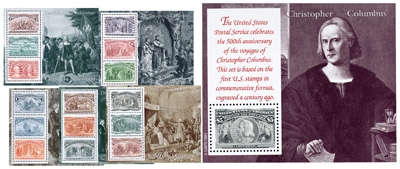
Each ride consisted of two revolutions – one for all of the cars to be filled, and another continuous trip around, which last nine minutes. Riding up in the sky, they could see the whole expo’s grounds, plus the neighboring states of Wisconsin, Indiana, and Michigan. The Ferris wheel consisted of 36 cars, each of which had 40 revolving chairs, but could hold up to 60 people. In all, the wheel carried about 38,000 people daily and over one million people over the course of the fair.
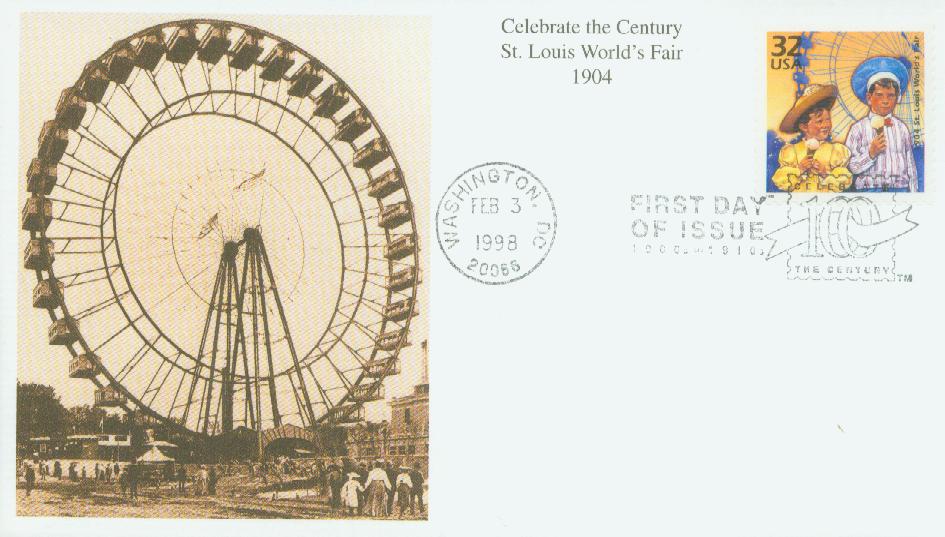
The exposition ended that October and the wheel remained in operation until April 1894. After that, it was taken apart and stored. The following year it was reassembled and remained in operation on the city’s north side until 1903. That year it was taken apart again and sent to St. Louis for the 1904 World’s Fair. After that fair ended, the wheel was destroyed by dynamite in 1906.
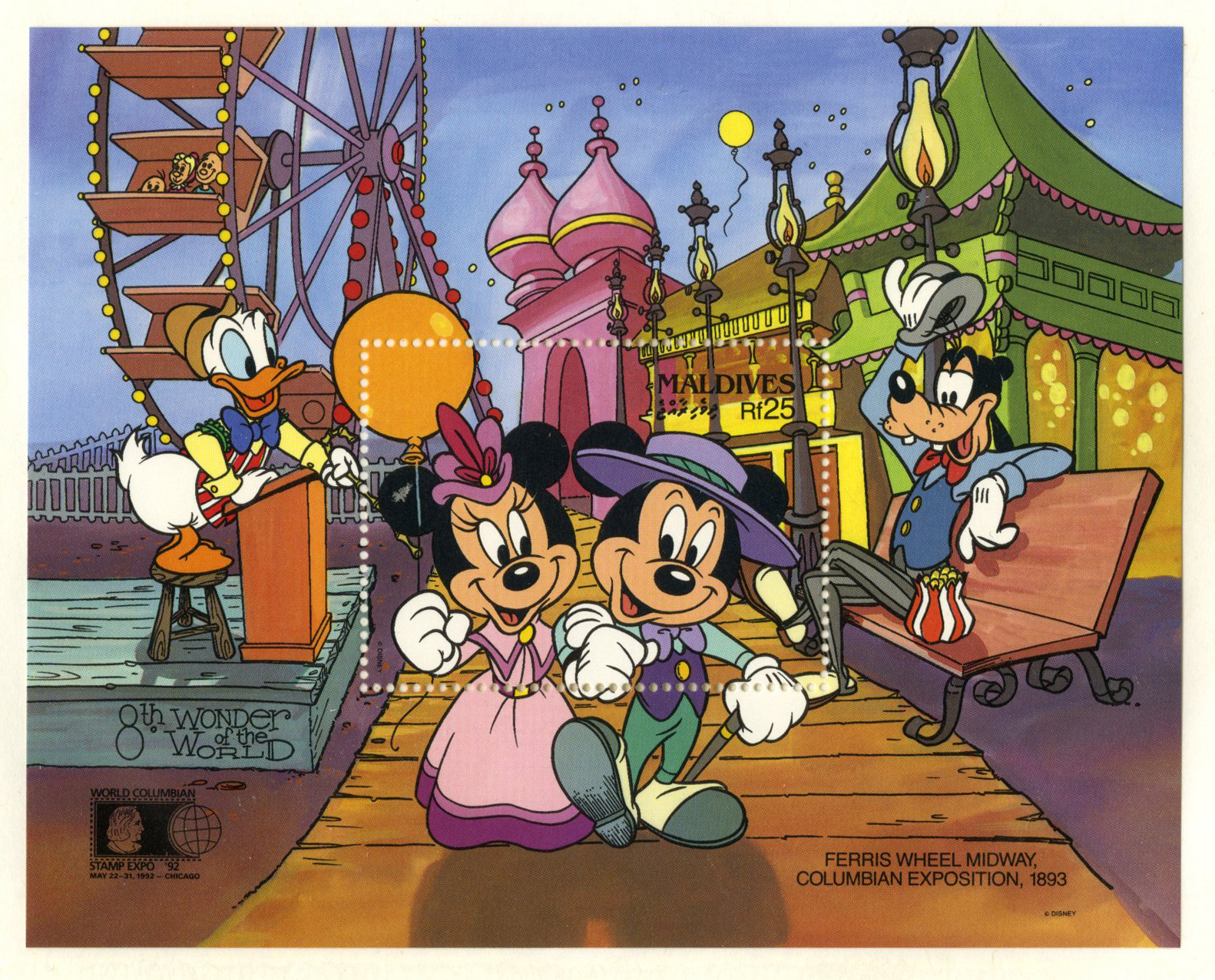
Prior to George Ferris’ wheel, pleasure wheels had been a popular attraction as early as the 1600s. In fact, Ferris had ridden a 53-foot pleasure wheel in 1892, and was later sued for copying the idea. However, he successfully argued that the technology involved in the Ferris wheel was vastly different. In the years since countless other wheels have been built around the world, but they are often still referred to as Ferris Wheels. Currently, the largest Ferris wheel in the world is the High Roller in Las Vegas, which measures 550′ tall.
1998 32¢ St. Louis World’s Fair
Celebrate the Century – 1900s
City: Washington, DC
Quantity: 12,533,333
Printed By: Ashton-Potter (USA) Ltd
Printing Method: Lithographed
Perforations: 11 ½
Color: Multicolored
Premiere Of The First Ferris Wheel
The planners behind the exposition saw it as their chance to put America’s engineering talent on display for the world to see. Construction Chief Daniel Burnham wanted his architects and engineers to come up with something even better than the Eiffel Tower, which had wowed visitors to the 1889 World’s Fair.

Among those who answered Burnham’s call was 32-year-old George Ferris. Ferris shared his plan for a giant observation wheel. However, the sheer size of it seemed impossible and he was rejected and his idea considered crazy. In spite of their reactions, Ferris believed in his idea and finished his plans and found the funding he needed. He negotiated with the expo’s planners and was given a plot to build the wheel on the Midway.
By the time the fair opened on May 1, 1893, the wheel was still under construction. Visitors to the fair guessed at what it might be. What they saw was a giant wheel reaching 264 feet tall. Its steel structure weighed hundreds of thousands of pounds. And its 90,000-pound axle was the largest hollow forging ever produced at the time.
The wheel was finally ready on June 21, 1893. That day George Ferris addressed the crowd of excited visitors and announced that he “had gotten the wheels out of his head and made them a living reality.” Shortly after his speech, the steam-powered wheel began to turn and the first riders were admitted. It was unlike anything the people of the day had experienced. For 50¢, twice the cost of admission to the fair, a person could experience Ferris’ Great Wheel.

Each ride consisted of two revolutions – one for all of the cars to be filled, and another continuous trip around, which last nine minutes. Riding up in the sky, they could see the whole expo’s grounds, plus the neighboring states of Wisconsin, Indiana, and Michigan. The Ferris wheel consisted of 36 cars, each of which had 40 revolving chairs, but could hold up to 60 people. In all, the wheel carried about 38,000 people daily and over one million people over the course of the fair.

The exposition ended that October and the wheel remained in operation until April 1894. After that, it was taken apart and stored. The following year it was reassembled and remained in operation on the city’s north side until 1903. That year it was taken apart again and sent to St. Louis for the 1904 World’s Fair. After that fair ended, the wheel was destroyed by dynamite in 1906.

Prior to George Ferris’ wheel, pleasure wheels had been a popular attraction as early as the 1600s. In fact, Ferris had ridden a 53-foot pleasure wheel in 1892, and was later sued for copying the idea. However, he successfully argued that the technology involved in the Ferris wheel was vastly different. In the years since countless other wheels have been built around the world, but they are often still referred to as Ferris Wheels. Currently, the largest Ferris wheel in the world is the High Roller in Las Vegas, which measures 550′ tall.






